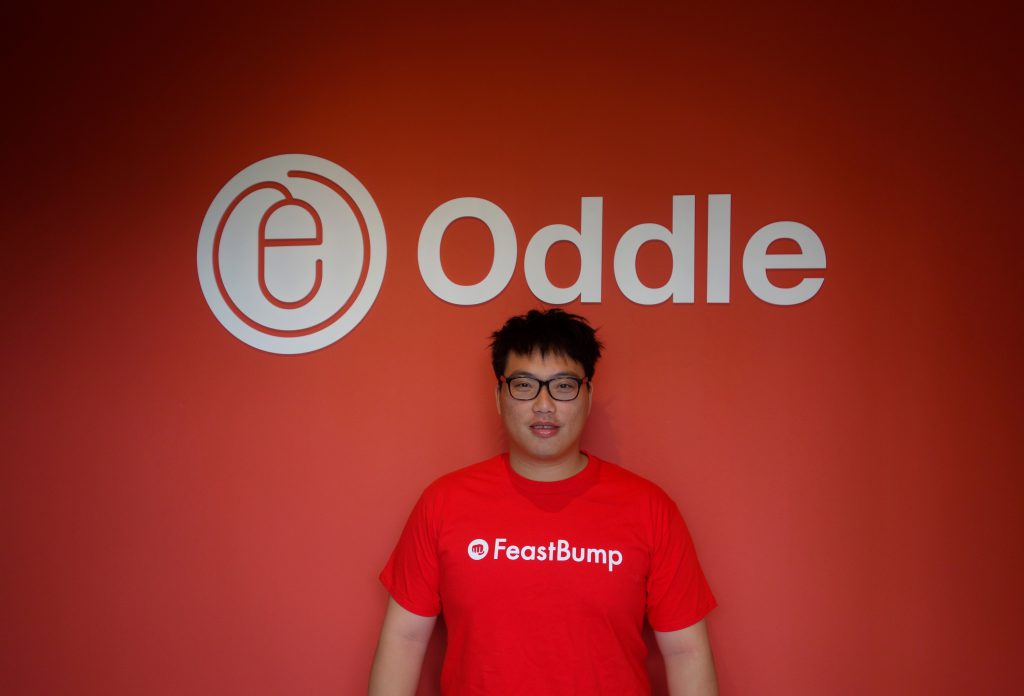The rise of food delivery demand has brought about the corresponding rise in service providers, many of whom engage in services which host a large number of restaurants.
Lim Ze Yan, better known as the founder of Oddle and owner of The Lawn Cafe, is back with FeastBump, a startup which wants to make food delivery even better.
“The 3 main aspects of online food businesses are operations, logistics & marketing. Oddle focuses on Operations and Logistics while FeastBump aims to cover Marketing for our F&B clients.”
Confused?
Basically, Oddle caters to F&B business owners engaging in food delivery services, while FeastBump serves both consumers and providers – think of it as an alternative to current food delivery options available.
Since both startups are interlinked (not only because of a common founder), let’s first start with the one which came first – Oddle.
The Origins Of Oddle
A food business owner himself, Ze Yan understood the pains that went into engaging delivery providers alongside running a bustling food business.
“The high commissions paid for each order were painful, especially when I received large orders. While it did bring in more orders and help in marketing, I wasn’t able to engage with customers and build a relationship with them. Marketplaces are perfect for restaurants that are starting out but for restaurants like us who are keen to grow our delivery business, we may end up overpaying for repeated customers in the long term if we rely solely on marketplaces.”
This was when he launched Oddle in March 2014, with the aim to build a friendly, close-knit eco-system and make food delivery actually work for F&B business owners.

By giving them an easy, affordable option to manage their front and back end, Oddle “is able to provide restaurants their own ‘virtual store’ and help them bring their offline business online”.
Why it is considerably more affordable for restaurant owners is also because while other competitors take a slice of each transaction, Oddle charges a flat fee for every outlet, with subsequent outlets costing more.
It may seem more expensive in the short run, but the transaction-based approach can potentially cost a lot more if the businesses are particularly popular.
Customisable Shopfronts, Call To Action Buttons
Existing food delivery services offer a plethora of restaurants for consumers to choose from, but their ‘shopfronts’ are usually boringly generic, so Oddle gives owners full autonomy to manage their promotions, shopping carts and even directly liaise with their customers.
They also promise to convert visitors to websites and Facebook pages into customers, with Call To Action buttons leading to the Oddle-powered online ordering menu.

Having over 1,500 partners on board, I think it’s safe to say that Oddle’s subtle consideration of getting visitors to take action quickly is effective.
Managing Peak Hour Logistical Nightmares
With a first-hand understanding that peak hours are a daily nightmare for logistics and food preparation, pre-order options for consumers are also available.
Through that, business are able to better plan ahead their kitchen capacity and increase revenue by utilising their resources during non-peak periods to prepare for peak hour-standard delivery demand.
On top of that, Oddle also provides its restaurant partners compiled data on all their transaction information, and weekly sales reports in Excel sheet format – making it a timesaver for those who intend on crunching data to see what works and what doesn’t.
In spite of all this, Ze Yan sees Oddle as a ‘complementary product’, and not a replacement for other food delivery channels.
“Marketplaces are great distribution channels to reach out to new customers while Oddle helps restaurants with customer retention and brand building.”
FeastBump – Linking Consumers To Providers
“While we strongly believe each restaurant should invest in building and promoting their online business, we see FeastBump providing additional support for restaurants that do not have the marketing resource.”
Launched officially this year, FeastBump (which uses Oddle’s order management system) has so far linked with over 200 bakeries and restaurants locally, and aims to drive more online food orders and create meaningful connections between their partners and consumers.
“We believe in building a sustainable eco-system where restaurants are able to build brand loyalty, retain customer data and pay reasonable amounts for marketing.”
Brand Loyalty Via Personalised Experiences
Being a food business owner himself, Ze Yan definitely sees the impact that brand loyalty brings to the table, and FeastBump aims to enhance that by making the ordering process as personalised as possible.
Cross-promotions are also incorporated into the process, thus not only linking restaurants to their customers, but restaurants to each other as well.
Ze Yan cites the example of the system recommending detox juice to go along with a salad that has been chosen, which makes great sense for consumers and merchants – with both getting more exposure to more options and customer bases respectively.
To make the experience even more personalised for consumers, a food concierge team is also available via live chat (yes – there’s an actual person replying to your food woes!) on their website to recommend alternatives lest more options are needed.

Advanced Orders – More Options, Less Waiting
“We order food ourselves and we know that it is not easy to feed a group of people, whether for team lunches or family gatherings. With our concierge team, our goal is to make it hassle-free for customers when it comes to online food ordering.”
In line with that, FeastBump features an advanced order option, so you can order food for an event (like a party, or even a meeting) up to weeks in advance.
I remember when my colleagues and I were trying to order food for a birthday celebration for my colleague, and we had to settle for a not-so-ideal option simply because of the lack of choices that could deliver our food fast enough.
I think it’s safe to say that with the pre-order option, we can not only have a larger variety of options, but also not suffer long waiting times because the restaurant would be able to anticipate and prepare for our order.
For those who prefer to cut short the queue and wait times for food, pick up options are also available.
Oddle-coming Bumps In The Journey
As with all startup stories, the setting up of FeastBump and Oddle was also not an entirely smooth ride, and a whole lot needed to be done:
“At the start, we were trying to figure out product-market fit, getting our value propositions right, forming the right team, setting up necessary processes, getting user feedback and incorporating them into product development.”
However, Ze Yan cites their openness to receiving constructive feedback from partners and pioneer users as “a joy”. “[Focusing] on what worked and celebrating small milestones” also kept the team motivated.

It is perhaps this commitment to engage and improve that has made both Oddle and FeastBump so successful.
The Future Of Food Delivery
If trends and reports are right, the food delivery market will only continue to grow in Singapore.
I asked Ze Yan, who has experience on both sides of the business as a restaurant owner and a delivery provider about his opinions:
“Yes we believe so. Rental hikes exert immense pressure on restaurants to find ways to increase their revenue. Food delivery is a good way for restaurants to expand their revenue channels. In fact, pure food delivery companies might become a trend in the future if the cost of logistics gets lower than the cost of rental.”
Running a F&B business in Singapore is no affordable venture, with rentals, utilities bills, buying of fresh ingredients and labour costs eating away chunks of whatever earnings one gets.
And all that has inevitably taken a toll on local businesses. According to a study by SPRING last year, “only 60% of businesses survive after the 5th year, the average business runs at an annual loss of 8%, and it takes an average of 2.5 years to recoup one’s initial investment”.
Engaging in food delivery can not only expand a restaurant’s reach to more consumers, but non-peak hours can also be rendered more productive with preparations for pre-orders – definitely a better use of rental bills as compared to sitting around with nothing to do for a few hours every day.

When asked for words of wisdom to aspiring entrepreneurs and startup founders wanting to make a difference, Ze Yan says:
“Be relentless, be obsessive.”
From the way his 2 startups have been thoughtfully crafted and executed to meet the needs of all involved in food delivery, I think he’s definitely a prime example of practicing what you preach.













